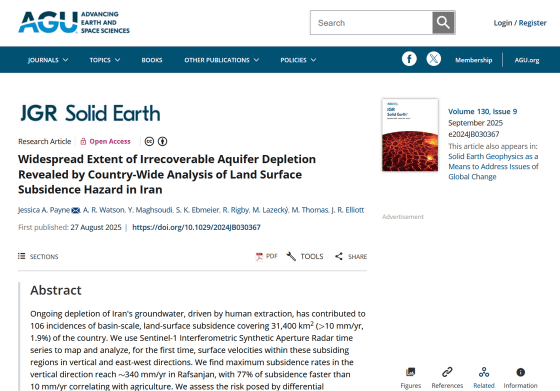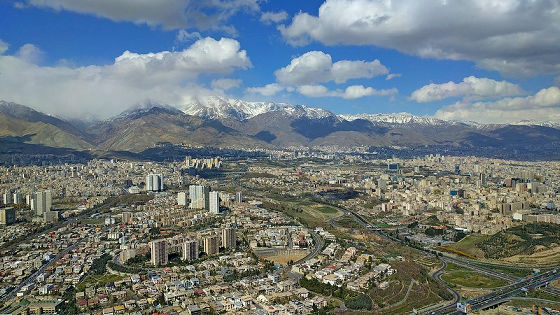Iran is one of the world's most severe subsidence hotspots, study finds

Widespread Extent of Irrecoverable Aquifer Depletion Revealed by Country‐Wide Analysis of Land Surface Subsidence Hazard in Iran - Payne - 2025 - Journal of Geophysical Research: Solid Earth - Wiley Online Library
https://agupubs.onlinelibrary.wiley.com/doi/10.1029/2024JB030367

Iran among 'world's most extreme subsidence hotspots' with some areas sinking up to 1 foot per year, study finds | Live Science
https://www.livescience.com/planet-earth/iran-among-worlds-most-extreme-subsidence-hotspots-with-some-areas-sinking-up-to-1-foot-per-year-study-finds
In Iran, a country with arid terrain, about 60% of its water supply comes from underground aquifers . To understand how this is affecting the land surface, Jessica Payne, a doctoral student at the University of Leeds' School of Earth and Environmental Studies in the UK, and her team used laser data from the European Space Agency's (ESA) Sentinel-1 satellite constellation to map changes in Iran's surface elevation from 2014 to 2022.
Analysis of the data revealed that land subsidence is occurring at a rate of more than 10 mm per year in 106 areas covering an area of approximately 31,400 square kilometers, equivalent to about 2% of Iran's land area. In particular, land subsidence near the city of Rafsanjan in central Iran is reported to be more than 34 cm per year.
The researchers say widespread land subsidence in Iran puts an estimated 650,000 people at increased risk of water shortages, food insecurity, and other threats caused by changes in ground level.
'Iran's rates of land subsidence are among the fastest in the world,' Payne told Live Science. 'We've identified around 100 locations across Iran where the land is sinking at rates of more than 10mm per year. In Europe, even subsidence of more than 5-8mm per year is considered extreme.'

by
Rapid land subsidence in Iran is believed to be caused by excessive groundwater pumping, and 77% of cases of land subsidence of 10 mm or more per year are related to agriculture. For example, the area around Rafsanjan city, where land subsidence is particularly severe, has an extremely dry climate, but groundwater resources are heavily used for pistachio plantations.
Regarding the 34cm annual land subsidence near Rafsanjan, Payne said, 'The ground will sink by about 3 to 4 meters in 10 years. This is a very serious situation.' The biggest problem is that most of this land subsidence is irreversible.
According to Payne, aquifers that receive roughly the same amount of water each year and are replenished by rainfall and other sources experience a seasonal rise and fall of the ground, known as elastic recovery. However, if the amount of water pumped out exceeds the amount of water replenished, the equilibrium is upset, compressing the particles that make up the aquifer and causing irreversible ground subsidence. Even if water later replenishes the compressed area, the ground will never rise to its original position.
Subsidence can cause cracks in the ground and destabilize structures, potentially damaging buildings, roads, and railways. 'It's hard to hear about the impacts from outside Iran, but I've heard from my Iranian colleagues that some buildings have had to be abandoned,' Payne said.

Land subsidence is not limited to Iran; large-scale subsidence is also known to be occurring in major cities in central Mexico, the United States, China, Italy, and other countries. Manouchehr Shirzaei , an associate professor of geophysics at Virginia Tech who was not involved in the paper, said, 'Iran's peak subsidence rate is comparable to that of Mexico City and California's Central Valley, making it one of the most severe subsidence hotspots in the world.'
Disasters related to land subsidence are not uncommon, and it has been pointed out that the collapse of a subway viaduct in Mexico City in 2021 was one of the causes of the slope caused by land subsidence. The accident resulted in the deaths of 26 people and nearly 80 injuries.
Shirzaei also pointed out that subsidence also has adverse effects on freshwater supplies: 'If aquifers continue to compress, much of their water storage capacity will be permanently lost. This will exacerbate water scarcity during droughts, reduce resilience to climate change, and make recovery increasingly difficult,' he said.
Related Posts:
in Free Member, Science, Posted by log1h_ik







